
Turkish art (Turkish: Türk sanatı) refers to all works of visual art originating from the geographical area of what is present day Turkey since the arrival of the Turks in the Middle Ages. Turkey also was the home of much significant art produced by earlier cultures, including the Hittites, Ancient Greeks, and Byzantines. Ottoman art is therefore the dominant element of Turkish art before the 20th century, although the Seljuks and other earlier Turks also contributed. The 16th and 17th centuries are generally recognized as the finest period for art in the Ottoman Empire, much of it associated with the huge Imperial court. In particular the long reign of Suleiman the Magnificent from 1520 to 1566 brought a combination, rare in any ruling dynasty, of political and military success with strong encouragement of the arts.[1]
The nakkashane, as the palace workshops are now generally known, were evidently very important and productive, but though there is a fair amount of surviving documentation, much remains unclear about how they operated. They operated over many different media, but apparently not including pottery or textiles, with the craftsmen or artists apparently a mixture of slaves, especially Persians, captured in war (at least in the early periods), trained Turks, and foreign specialists. They were not necessarily physically located in the palace, and may have been able to undertake work for other clients as well as the sultan. Many specialities were passed from father to son.[2]
Seljuk period

%252C_Berlin.jpg.webp)
Seljuk architecture involves the building traditions of the Seljuk dynasty when it ruled most of the Middle East (Great Seljuk Empire) and Anatolia (Sultanate of Rum) between the 11th and 13th centuries. The Great Seljuk Empire contributed significantly to the architecture of Iran and surrounding regions, introducing innovations such as the symmetrical four-iwan layout and the first widespread creation of state-sponsored learning institutions madrasas. Their buildings were generally constructed in brick, with decoration created using brickwork, tiles, and carved stucco.
Most Anatolian Seljuk works are of dressed stone, with brick reserved for minarets. The use of stone in Anatolia is the biggest difference with the Seljuk buildings in Iran, which are made of bricks. This also resulted in more of their monuments being preserved up to modern times.[3] In their construction of caravanserais, madrasas and mosques, the Anatolian Seljuks translated the Iranian Seljuk architecture of bricks and plaster into the use of stone.[4]
The architects that the Seljuks built during this period were of great importance in art. Seljuk structures built during the Golden Age of Islam often include geometrical patterns in their motifs. Seljuks used tiles many times in their art and they painted parts of their social life on ceramics. Generally, they used the khatun and the bey gether in their ceramics. At the same time, many depictions of male and female cavalry were found in Seljuk paintings. They frequently used the color turquoise in their works and today it has gained a unique feature.
Ottoman period
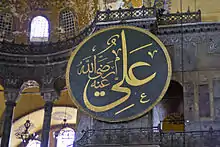


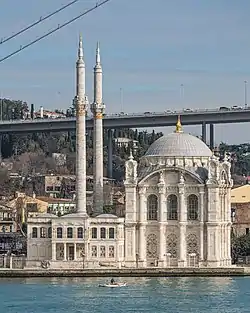
Ottoman architecture developed traditional Islamic styles, with some technical influences from Europe, into a highly sophisticated style, with interiors richly decorated in coloured tiles, seen in palaces, mosques and turbe mausolea.[5]
Other forms of art represented developments of earlier Islamic art, especially those of Persia, but with a distinct Turkish character. As in Persia, Chinese porcelain was avidly collected by the Ottoman court, and represented another important influence, mainly on decoration.[6] Ottoman miniature and Ottoman illumination cover the figurative and non-figurative elements of the decoration of manuscripts, which tend to be treated as distinct genres, though often united in the same manuscript and page.[7]
The reign of the Ottomans in the 16th and early 17th centuries introduced the Turkish form of Islamic calligraphy. This art form reached the height of its popularity during the reign of Suleiman the Magnificent (1520–66).[8] As decorative as it was communicative, Diwani was distinguished by the complexity of the line within the letter and the close juxtaposition of the letters within the word. The hilya is an illuminated sheet with Islamic calligraphy of a description of the Islamic prophet Muhammad. The tughra is an elaborately stylized formal signature of the sultan, which like the hilya performed some of the functions of portraits in Christian Europe. Book covers were also elaborately decorated.[9]
Other important media were in the applied or decorative arts rather than figurative work. Pottery, especially İznik pottery, jewellery, hardstone carvings, Turkish carpets, woven and embroidered silk textiles were all produced to extremely high standards, and carpets in particular were exported widely. Other Turkish art ranges from metalwork, carved woodwork and furniture with elaborate inlays to traditional Ebru or paper marbling.[10]
18th to 20th centuries
In the 18th and 19th centuries Turkish art and architecture became more heavily influenced by contemporary European styles, leading to over-elaborated and fussy detail in decoration.[11] European-style painting was slow to be adopted, with Osman Hamdi Bey (1842–1910) for long a somewhat solitary figure. He was a member of the Ottoman administrative elite who trained in Paris, and painted throughout his long career as a senior administrator and curator in Turkey. Many of his works represent the subjects of Orientalism from the inside, as it were.
20th century and onward
| Part of a series on the |
| Culture of Turkey |
|---|
 |
| Languages |
| Mythology and Folklore |
| Cuisine |
| Festivals |
| Religion |
| Art |
| Literature |
A transition from Islamic artistic traditions under the Ottoman Empire to a more secular, Western orientation has taken place in Turkey. Modern Turkish painters are striving to find their own art forms, free from Western influence. Sculpture is less developed, and public monuments are usually heroic representations of Atatürk and events from the war of independence. Literature is considered the most advanced of contemporary Turkish arts.
Gallery
Architecture
_Entrance_8685_(cropped).jpg.webp) Entrance of the Çifte Minareli Medrese in Erzurum (c. 1250)
Entrance of the Çifte Minareli Medrese in Erzurum (c. 1250)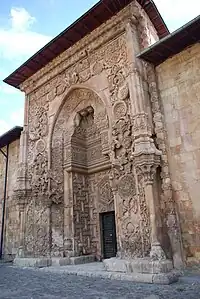 Entrance of the Divriği Mosque, Sivas (c. 1229)
Entrance of the Divriği Mosque, Sivas (c. 1229)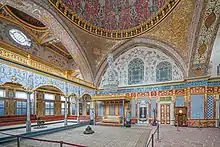 Imperial Hall in Harem of Topkapı Palace in Istanbul
Imperial Hall in Harem of Topkapı Palace in Istanbul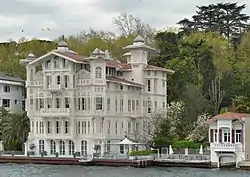 Istanbul Yalı architecture
Istanbul Yalı architecture An example of the Yalı architecture
An example of the Yalı architecture.jpg.webp) Safranbolu, an Ottoman village
Safranbolu, an Ottoman village
.jpeg.webp) Interior of a dome at Dolmabahçe Palace
Interior of a dome at Dolmabahçe Palace Mihrab niche of Bursa Grand Mosque
Mihrab niche of Bursa Grand Mosque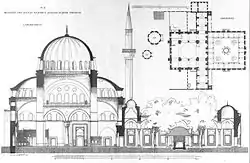 Cross section and plan of Bayezid II Mosque, the oldest imperial complex in Istanbul that is preserved in more or less its original form
Cross section and plan of Bayezid II Mosque, the oldest imperial complex in Istanbul that is preserved in more or less its original form.jpg.webp)
 Exterior design of Selimiye Mosque, Edirne
Exterior design of Selimiye Mosque, Edirne Interior decoration of the dome of Selimiye Mosque, Edirne
Interior decoration of the dome of Selimiye Mosque, Edirne
 Old Fatih Municipality Building
Old Fatih Municipality Building Liman Han (inn)
Liman Han (inn)
Calligraphy
_-_Google_Art_Project.jpg.webp) Sample training of Abdul Rahman Hilmi, ink, colours and gold on paper
Sample training of Abdul Rahman Hilmi, ink, colours and gold on paper Gold illuminated two opening chapters of the Holy Koran by Mehmed Şevki Efendi
Gold illuminated two opening chapters of the Holy Koran by Mehmed Şevki Efendi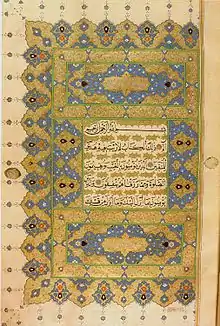
%252C_by_Hafiz_Osman_(CBL_T_559.4).jpg.webp)

 Decorated tughra of Suleyman the Magnificent (1520)
Decorated tughra of Suleyman the Magnificent (1520) A decree with royal tughra on top for appointing second imam in the Mehmed Sultan Mosque in Ohrid, Republic of Macedonia
A decree with royal tughra on top for appointing second imam in the Mehmed Sultan Mosque in Ohrid, Republic of Macedonia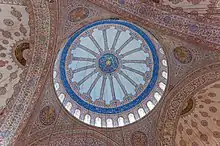 Main dome of the Blue Mosque with calligraphy inscriptions
Main dome of the Blue Mosque with calligraphy inscriptions The testimony of faith (top) and tughras (right and left) inscribed on the entrance to a building at Topkapi Palace, Istanbul
The testimony of faith (top) and tughras (right and left) inscribed on the entrance to a building at Topkapi Palace, Istanbul
Carpets
.jpg.webp) Anatolian double-niche rug, Konya region, circa 1750–1800
Anatolian double-niche rug, Konya region, circa 1750–1800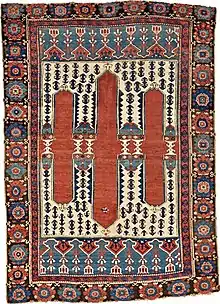 Bergama rug
Bergama rug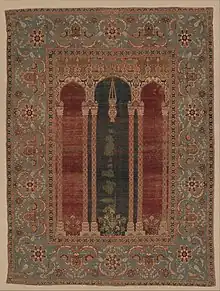





Culinary art
Dance
 A modern Ottoman military band (mehter) troop
A modern Ottoman military band (mehter) troop A traditional Turkish folk dance team
A traditional Turkish folk dance team_-_Turkish_dance_group_01.jpg.webp) Turkish Belly Dance at the 18th International Folklore Festival, 2012, Plovdiv, Bulgaria
Turkish Belly Dance at the 18th International Folklore Festival, 2012, Plovdiv, Bulgaria_-_Turkish_dance_group_12.jpg.webp) A children's folk dance team from the Black Sea region
A children's folk dance team from the Black Sea region_-_Turkish_dance_group_22.jpg.webp) Turkish dance group
Turkish dance group_-_Turkish_dance_group_34.jpg.webp) Turkish dance group
Turkish dance group Zeybek Dancer
Zeybek Dancer
Fashion

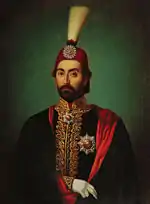 Sultan Abdul Majid, Pera Museum
Sultan Abdul Majid, Pera Museum Turkish model at a fashion show, Brussels, Belgium
Turkish model at a fashion show, Brussels, Belgium Turkish model at a fashion show, Brussels, Belgium
Turkish model at a fashion show, Brussels, Belgium Military Pictures from the Ralamb Costume Book, 1657
Military Pictures from the Ralamb Costume Book, 1657%252C_Turkey%252C_early_1900s%252C_silk%252C_cotton%252C_with_skirt_(right)%252C_Syria%252C_late_1800s%252C_silk%252C_cotton_-_Rautenstrauch-Joest-Museum_-_DSC00338.jpg.webp) Women's dress, late 1800s, Syria (right) and coat from early 1900s, silk and cotton (left), exhibit in the Rautenstrauch-Joest-Museum, Cologne, Germany
Women's dress, late 1800s, Syria (right) and coat from early 1900s, silk and cotton (left), exhibit in the Rautenstrauch-Joest-Museum, Cologne, Germany.jpg.webp) Historical Turkish costumes, 1880s, Smithsonian Libraries
Historical Turkish costumes, 1880s, Smithsonian Libraries Ashjibashi (head cook) of the Janissaries in ceremonial uniform
Ashjibashi (head cook) of the Janissaries in ceremonial uniform The Kul Kethüdası, commander of the third division of the Janissaries
The Kul Kethüdası, commander of the third division of the Janissaries Silahdar Agha, sword-bearer of the Sultan
Silahdar Agha, sword-bearer of the Sultan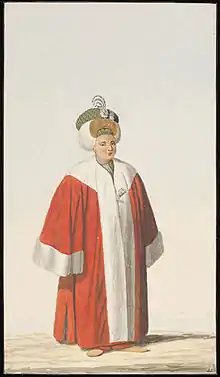 A Şehzade, Ottoman prince of the blood
A Şehzade, Ottoman prince of the blood
Handcraft
 Minbar of the Alaeddin Mosque in Konya, dated to 1155–1156. This minbar is a prime example of the kündekâri technique, in which many interlocking pieces of wood are held together without the use of nails, pins, or glue
Minbar of the Alaeddin Mosque in Konya, dated to 1155–1156. This minbar is a prime example of the kündekâri technique, in which many interlocking pieces of wood are held together without the use of nails, pins, or glue Individual pieces are carved with vegetal arabesque motifs within the wider geometric motif formed by the different pieces
Individual pieces are carved with vegetal arabesque motifs within the wider geometric motif formed by the different pieces_2340.jpg.webp) Front part of Alaeddin Mosque's minbar
Front part of Alaeddin Mosque's minbar The carved wood minbar of the Divriği Great Mosque and Hospital in Sivas, an example of Seljuk handicraft
The carved wood minbar of the Divriği Great Mosque and Hospital in Sivas, an example of Seljuk handicraft Detail of the Divriği minbar: the lines between the wooden boards mounted side-by-side are visible, while the surface itself is carved with motifs imitating kündekâri work
Detail of the Divriği minbar: the lines between the wooden boards mounted side-by-side are visible, while the surface itself is carved with motifs imitating kündekâri work Minbar of the Great Mosque of Siirt (13th century), now housed in the Ethnography Museum of Ankara
Minbar of the Great Mosque of Siirt (13th century), now housed in the Ethnography Museum of Ankara Stained glass windows at Topkapı Palace
Stained glass windows at Topkapı Palace.jpg.webp) A room at Topkapı Palace, carpet with a small-pattern "Holbein" design
A room at Topkapı Palace, carpet with a small-pattern "Holbein" design
Illumination
.jpg.webp) Single-volume Qur’an. Copied by Khalil Allah ibn Mahmud Shah, illuminated by Muhammad ibn Ali
Single-volume Qur’an. Copied by Khalil Allah ibn Mahmud Shah, illuminated by Muhammad ibn Ali.jpg.webp) Page from Ottoman Qur'an. Ink, color, and gold on paper. Probably Edirne
Page from Ottoman Qur'an. Ink, color, and gold on paper. Probably Edirne.jpg.webp) Hilye-i Şerif Anthology, early 19th century in Sadberk Hanım Museum
Hilye-i Şerif Anthology, early 19th century in Sadberk Hanım Museum Qur'an copied by Abdullah Zühdi
Qur'an copied by Abdullah Zühdi The name 'Muhammad' is written in mirrored thuluth script, and filled with Qur'anic verses in ghubar
The name 'Muhammad' is written in mirrored thuluth script, and filled with Qur'anic verses in ghubar.jpg.webp) Hilye-i Şerif. Unknown, Ottoman, circa 1725 in Sadberk Hanım Museum
Hilye-i Şerif. Unknown, Ottoman, circa 1725 in Sadberk Hanım Museum.jpg.webp) "Divan-i Muhibbi",Calligraphy in nastaliq by Mehmed Şerif, illumination by Kara Memi, Istanbul, 1566
"Divan-i Muhibbi",Calligraphy in nastaliq by Mehmed Şerif, illumination by Kara Memi, Istanbul, 1566
Miniature
 An Ottoman official miniature
An Ottoman official miniature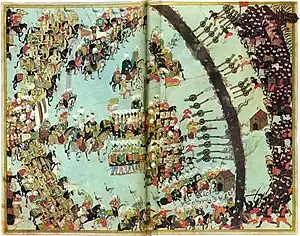 Miniature depiction of the Battle of Mezőkeresztes, Hungary (1596)
Miniature depiction of the Battle of Mezőkeresztes, Hungary (1596) Capture of Buda (1526)
Capture of Buda (1526) Miniature depicting the Siege of Nice, France (1543) by Matrakçı Nasuh
Miniature depicting the Siege of Nice, France (1543) by Matrakçı Nasuh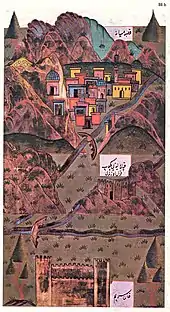 16th century map of Miyaneh by Matrakçı Nasuh
16th century map of Miyaneh by Matrakçı Nasuh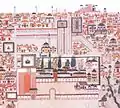
 Selim II ascends to the throne
Selim II ascends to the throne Topkapı Palace during the reign of Selim I
Topkapı Palace during the reign of Selim I Use of fireworks during the celebrations.
Use of fireworks during the celebrations.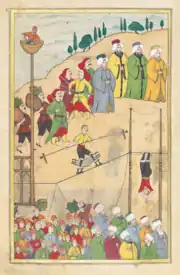 Acrobats during celebrations
Acrobats during celebrations Ships of parade
Ships of parade
Painting
 Two Musician Girls by Osman Hamdi Bey
Two Musician Girls by Osman Hamdi Bey The Tortoise Trainer by Osman Hamdi Bey, 1906
The Tortoise Trainer by Osman Hamdi Bey, 1906 Work by Osman Hamdi Bey
Work by Osman Hamdi Bey Arzuhalci by Osman Hamdi Bey
Arzuhalci by Osman Hamdi Bey
Sculpture
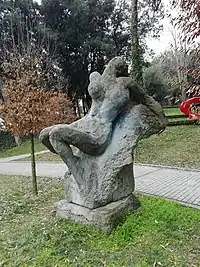 Güzel İstanbul by Gürdal Duyar
Güzel İstanbul by Gürdal Duyar Akdeniz by İlhan Koman
Akdeniz by İlhan Koman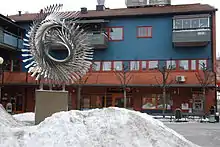 Water Swirl by İlhan Koman
Water Swirl by İlhan Koman Statue of Humanity by Mehmet Aksoy
Statue of Humanity by Mehmet Aksoy Efenin Aşkı by Hüseyin Gezer
Efenin Aşkı by Hüseyin Gezer
Tiles
 Cem Sultan tomb in Bursa, the first official capital of the Ottoman Empire
Cem Sultan tomb in Bursa, the first official capital of the Ottoman Empire Tiles of the circumcision room at Topkapi Palace
Tiles of the circumcision room at Topkapi Palace Tiles of the circumcision room at Topkapi Palace
Tiles of the circumcision room at Topkapi Palace The entrance to the Harem at Topkapi Palace
The entrance to the Harem at Topkapi Palace Eunuchs' Courtyard in Harem of Topkapı Palace
Eunuchs' Courtyard in Harem of Topkapı Palace_01.jpg.webp) Tile decoration on the Dome of the Rock, added during Sultan Suleiman's reign
Tile decoration on the Dome of the Rock, added during Sultan Suleiman's reign.jpg.webp) Tiles of the Rüstem Pasha Mosque
Tiles of the Rüstem Pasha Mosque Tiles of the Rüstem Paşa Mosque
Tiles of the Rüstem Paşa Mosque Tiles of the Rüstem Paşa Mosque
Tiles of the Rüstem Paşa Mosque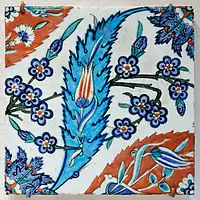
 Iznik (ancient Nicea) tiles
Iznik (ancient Nicea) tiles Tiles of the Imperial Council Second Courtyard
Tiles of the Imperial Council Second Courtyard
Weapons
 An Ottoman horse archer
An Ottoman horse archer Ottoman Mamluk horseman with mail and plate armour, 1550
Ottoman Mamluk horseman with mail and plate armour, 1550 Jeweled Ottoman sabres
Jeweled Ottoman sabres Kilij sword was in use from the early 17th century, for more than 300 years, well into the 20th century.
Kilij sword was in use from the early 17th century, for more than 300 years, well into the 20th century._sword.JPG.webp) Ottoman yataghan sword, 19th century or earlier.
Ottoman yataghan sword, 19th century or earlier. Decorated Ottoman cannon, 1581
Decorated Ottoman cannon, 1581 Ottoman rifles, 1750-1800
Ottoman rifles, 1750-1800
See also
Notes
- ↑ Levey, 12; Rogers and Ward, throughout, especially 26–41
- ↑ Rogers and Ward, 120–124; 186–188
- ↑ Hattstein & Delius 2011, p. 371.
- ↑ Blair & Bloom 2004, p. 130.
- ↑ Levey, throughout
- ↑ Levey, 54, 60; Rogers and Ward, 29, 186; Rawson, 183–191, and see index
- ↑ Levey, see index; Rogers and Ward, 59–119
- ↑ Rogers and Ward, 55–74
- ↑ Levey, see index; Rogers and Ward, 26–41, 62–64 on tughra
- ↑ Rogers and Ward, 120–215, cover a wide range; Levey, 51–55, and see index
- ↑ Levey, chapters 5 and 6
References
- Blair, Sheila; Bloom, Jonathan (2004). "West Asia:1000-1500". In Onians, John (ed.). Atlas of World Art. Laurence King Publishing.
- Hattstein, Markus; Delius, Peter, eds. (2011). Islam: Art and Architecture. H. F. Ullman. ISBN 9783848003808.
- Levey, Michael; The World of Ottoman Art, 1975, Thames & Hudson, ISBN 0500270651
- Rawson, Jessica, Chinese Ornament: The Lotus and the Dragon, 1984, British Museum Publications, ISBN 0714114316
- Rogers J.M. and Ward R.M.; Süleyman the Magnificent, 1988, British Museum Publications ISBN 0714114405
Further reading
- Binney, Edwin. Turkish Miniature Paintings and Manuscripts, from the Collection of Edwin Binney, 3rd. New York City: Metropolitan Museum of Art; Los Angeles, Calif.: Los Angeles County Museum of Art, 1973. 139 p., amply ill. (in b&w). N.B.: Catalogue of an exhibition held at the named museums. ISBN 0-87099-077-2
- Miller, Lenore D. Echoes of Anatolia: Works of Contemporary Turkish-American Artists ... [catalogue of an] Exhibition [which] Has Been Realized through the Generosity of the Contributing Artists and [of] the Turkish Embassy in Washington, D.C. [Washington, D.C., c. 1987]. 24 p., amply ill. (in black and white). Without ISBN